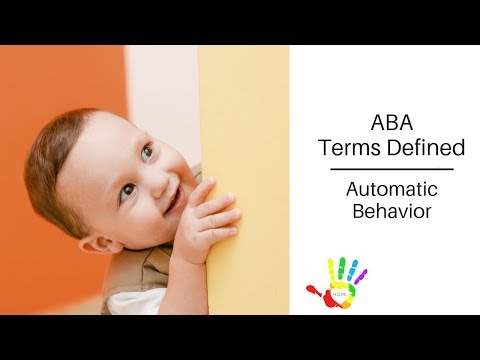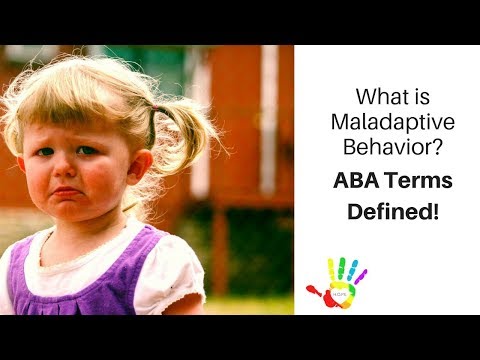Did you know that the kids with Autism who benefit the ABA therapy are the ones whose parents have the best understanding of the techniques used by their therapists?. This video is part of a very special series called ABA Terms Defined. It is designed to help parents like you understand the terms your therapist is using so you can have better conversations with your therapist and carryover the techniques he uses at home. This video describes the term, automatic behavior. <br> <h3>Auto Generated Captions</h3>
[Music]
hey guys my name is Jessica bikeways and
I’m the CEO of hope education services
I’m passionate about helping families
just like yours who have children with
autism to have a better understanding of
how to help their child and navigate
this crazy during the that you’re on so
I’ve been working with children with
autism as an EPA there is for more than
eleven years and I founded my company
hope education services to make
treatment available online for kids all
over the world so I create these videos
and this is part of a very special
series called ABA terms to find where
I’m sharing the definitions of these
terms that your ABA therapists are
probably throwing out there every day
that as a parent you may want to
understand and may not understand so
today we’re gonna be talking about when
we’re gonna be defining the term
automatic behavior now that sounds a
little weird right
so in ABA we have two types of behaviors
there’s social behaviors and there’s
automatic behaviors so an automatic
behavior is a behavior there doesn’t
involve another person so it’s
essentially anything that anyone does by
themselves so I am home in my house by
myself and I’m hungry so I go to the
microwave and I put some fit in and I
heat it up that’s an automatic behavior
because it’s nothing to do with anybody
else now if I would have asked someone
to give me food well that would be a
social behavior so the automatic again
it’s not involving anyone else so if I
tie my shoe and I am you know in my
house and by myself I’m an adult tie my
shoe or even if I’m out it doesn’t
matter if anyone else is around right
typically as adults you’re not asking
anyone to tie your shoe you’re just
telling your shoe by yourself hopefully
so that would be an automatic behavior
if the music is too loud and I’m driving
in my car and I turn the music down that
is an automatic behavior if I’m a
passenger in a car and I ask the driver
to turn the music down it’s a social
behavior so oftentimes though when it
refers to kids with autism when ABA
therapists are using the term automatic
behavior they’re actually referring to
self-stimulatory behaviors although like
I just said it’s not the only thing that
that refers to so that could be anything
like flapping your hands on rocking back
and forth jumping up and down lining
things up anything that a child
intrinsically does by themself that
doesn’t involve another person so the
idea is that they’re accessing the
reinforcer by themselves so that may be
a little confusing so the ABA there’s
always three parts of the behavior this
is the antecedent the behavior and then
the consequence so in the in with an
automatic behavior the antecedent is
always an intrinsic desire for either to
gain something or to take something away
so with automatic behaviors there’s
automatic positive behaviors and
automatic negative behaviors so in the
event that I were to want to turn the
radio off that would be an automatic
negative behavior because the music is
going away and that’s what’s reinforcing
my behavior my turning down the music
the music being turned off makes me
essentially happy right that’s why I did
it
and then automatic positive behavior
would be if I turn the radio on then the
music going on would then be the
reinforcer for that behavior so when it
comes to figuring out whether a
stimulatory behavior and this is where
again automatic behaviors mostly come in
when working with kids autism whether
it’s a self stemming behavior it’s hard
to know whether it’s an automatic
positive behavior or an automatic
negative behavior now in a VA we have
what’s called a private event which
means we can’t actually see it and since
we can’t see it we can really explain
the function of the behavior ABA is
really about observing behavior and
figuring out why people are doing things
well if you can’t figure out what
happened before the behavior we usually
look at the antecedent to figure out why
someone’s gauging in behavior what
happens before the behavior that gives
us all information we need since that’s
an intrinsic desire within somebody we
can actually observe that so we often
don’t know now you would always know if
you’re doing the behavior and sometimes
it’s obvious it’s
obvious is an automatic negative
behavior that would totally make sense
but in the event someone is doing
something like hitting their head on a
table I don’t know if they have a
headache and you know they’re trying to
make their head go ahead and go away I
don’t know I mean for some reason they
find that a pleasurable sensation
sometimes kids with autism they have
different sensory experiences with
things that may different from your eye
or even someone is flapping their arms
right I don’t know if they’re trying to
calm themselves down by doing that I
don’t know if they’re doing it just
because they like the way it feels it
can be hard to figure out so you can’t
always predict or can’t always tell
whether something’s in automatic
positive or automatic negative behavior
but the key thing I want you to know and
walk away from watching this video is an
automatic behavior is essentially
anything that anyone does that doesn’t
involve another person giving them
access to the reinforcer so I really
hope this video was helpful if it is I’d
love for you to connect with me on
youtube subscribe to this channel I put
tons of videos out just like this one
just for you it’s parent training videos
calm that’s where you can find my
channel and this is your first time
finding this video now I also just want
to let you know I love to answer your
questions I make sometimes I’m making
videos in this like this particular
video as part of this series where I’m
talking about all the different ABA
terms but sometimes I make questionnaire
and make videos just to answer parent
questions if you chat a question in on
this YouTube video in the comment
section I read and respond to all the
comments and I promise you I will make a
video for you to get your question
answered so I hope that you enjoy this I
hope to connect with you again if you
are interested in more free content I
want you to head over to my webpage it’s
hope education services com under the
section of free resources I have 4
ebooks and I love to just give you one
for free and to connect with you every
week on my weekly newsletter when I send
out videos like this and all sorts of
different blog posts with tips and
tricks on how to help your child so I
hope you make it an amazing week and I
hope to talk to you again soon
you
ABA Terms Defined: Automatic Behavior aASNIE7GmgU
[Music]
hey guys my name is Jessica bikeways and
I’m the CEO of hope education services
I’m passionate about helping families
just like yours who have children with
autism to have a better understanding of
how to help their child and navigate
this crazy during the that you’re on so
I’ve been working with children with
autism as an EPA there is for more than
eleven years and I founded my company
hope education services to make
treatment available online for kids all
over the world so I create these videos
and this is part of a very special
series called ABA terms to find where
I’m sharing the definitions of these
terms that your ABA therapists are
probably throwing out there every day
that as a parent you may want to
understand and may not understand so
today we’re gonna be talking about when
we’re gonna be defining the term
automatic behavior now that sounds a
little weird right
so in ABA we have two types of behaviors
there’s social behaviors and there’s
automatic behaviors so an automatic
behavior is a behavior there doesn’t
involve another person so it’s
essentially anything that anyone does by
themselves so I am home in my house by
myself and I’m hungry so I go to the
microwave and I put some fit in and I
heat it up that’s an automatic behavior
because it’s nothing to do with anybody
else now if I would have asked someone
to give me food well that would be a
social behavior so the automatic again
it’s not involving anyone else so if I
tie my shoe and I am you know in my
house and by myself I’m an adult tie my
shoe or even if I’m out it doesn’t
matter if anyone else is around right
typically as adults you’re not asking
anyone to tie your shoe you’re just
telling your shoe by yourself hopefully
so that would be an automatic behavior
if the music is too loud and I’m driving
in my car and I turn the music down that
is an automatic behavior if I’m a
passenger in a car and I ask the driver
to turn the music down it’s a social
behavior so oftentimes though when it
refers to kids with autism when ABA
therapists are using the term automatic
behavior they’re actually referring to
self-stimulatory behaviors although like
I just said it’s not the only thing that
that refers to so that could be anything
like flapping your hands on rocking back
and forth jumping up and down lining
things up anything that a child
intrinsically does by themself that
doesn’t involve another person so the
idea is that they’re accessing the
reinforcer by themselves so that may be
a little confusing so the ABA there’s
always three parts of the behavior this
is the antecedent the behavior and then
the consequence so in the in with an
automatic behavior the antecedent is
always an intrinsic desire for either to
gain something or to take something away
so with automatic behaviors there’s
automatic positive behaviors and
automatic negative behaviors so in the
event that I were to want to turn the
radio off that would be an automatic
negative behavior because the music is
going away and that’s what’s reinforcing
my behavior my turning down the music
the music being turned off makes me
essentially happy right that’s why I did
it
and then automatic positive behavior
would be if I turn the radio on then the
music going on would then be the
reinforcer for that behavior so when it
comes to figuring out whether a
stimulatory behavior and this is where
again automatic behaviors mostly come in
when working with kids autism whether
it’s a self stemming behavior it’s hard
to know whether it’s an automatic
positive behavior or an automatic
negative behavior now in a VA we have
what’s called a private event which
means we can’t actually see it and since
we can’t see it we can really explain
the function of the behavior ABA is
really about observing behavior and
figuring out why people are doing things
well if you can’t figure out what
happened before the behavior we usually
look at the antecedent to figure out why
someone’s gauging in behavior what
happens before the behavior that gives
us all information we need since that’s
an intrinsic desire within somebody we
can actually observe that so we often
don’t know now you would always know if
you’re doing the behavior and sometimes
it’s obvious it’s
obvious is an automatic negative
behavior that would totally make sense
but in the event someone is doing
something like hitting their head on a
table I don’t know if they have a
headache and you know they’re trying to
make their head go ahead and go away I
don’t know I mean for some reason they
find that a pleasurable sensation
sometimes kids with autism they have
different sensory experiences with
things that may different from your eye
or even someone is flapping their arms
right I don’t know if they’re trying to
calm themselves down by doing that I
don’t know if they’re doing it just
because they like the way it feels it
can be hard to figure out so you can’t
always predict or can’t always tell
whether something’s in automatic
positive or automatic negative behavior
but the key thing I want you to know and
walk away from watching this video is an
automatic behavior is essentially
anything that anyone does that doesn’t
involve another person giving them
access to the reinforcer so I really
hope this video was helpful if it is I’d
love for you to connect with me on
youtube subscribe to this channel I put
tons of videos out just like this one
just for you it’s parent training videos
calm that’s where you can find my
channel and this is your first time
finding this video now I also just want
to let you know I love to answer your
questions I make sometimes I’m making
videos in this like this particular
video as part of this series where I’m
talking about all the different ABA
terms but sometimes I make questionnaire
and make videos just to answer parent
questions if you chat a question in on
this YouTube video in the comment
section I read and respond to all the
comments and I promise you I will make a
video for you to get your question
answered so I hope that you enjoy this I
hope to connect with you again if you
are interested in more free content I
want you to head over to my webpage it’s
hope education services com under the
section of free resources I have 4
ebooks and I love to just give you one
for free and to connect with you every
week on my weekly newsletter when I send
out videos like this and all sorts of
different blog posts with tips and
tricks on how to help your child so I
hope you make it an amazing week and I
hope to talk to you again soon
you
https://i.ytimg.com/vi/aASNIE7GmgU/hqdefault.jpg autism,autistic,autism spectrum disorder,behavior,aba,applied beahvior analysis,applied behaviour analysis,automatic behavior,behavior therapy,education,spedical education,jessica leichtweisz,hope education services Did you know that the kids with Autism who benefit the ABA therapy are the ones whose parents have the best understanding of the techniques used by their therapists?. This video is part of a very special series called ABA Terms Defined. It is designed to help parents like you understand the terms your therapist is using so you can have better conversations with your therapist and carryover the techniques he uses at home. This video describes the term, automatic behavior.



